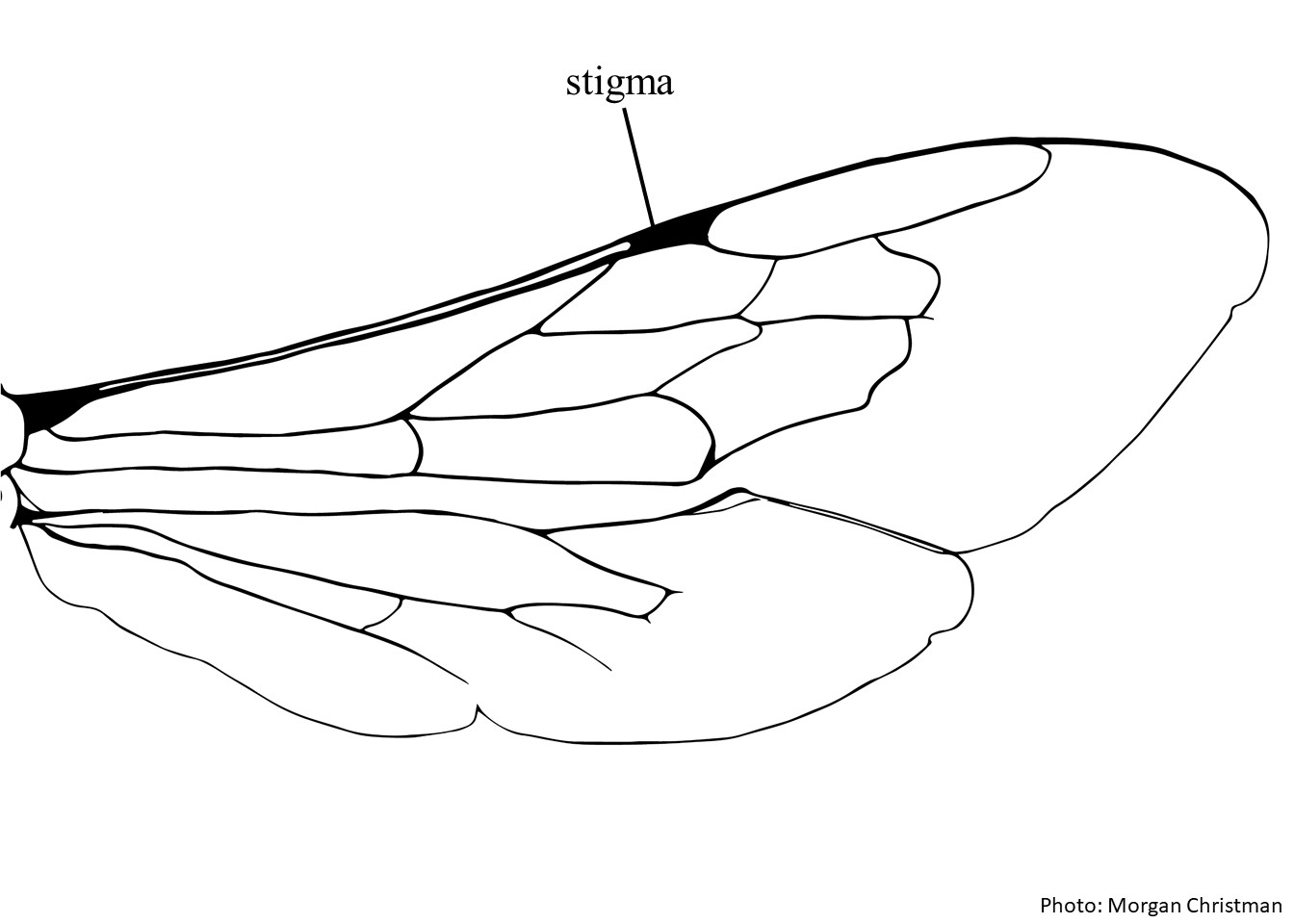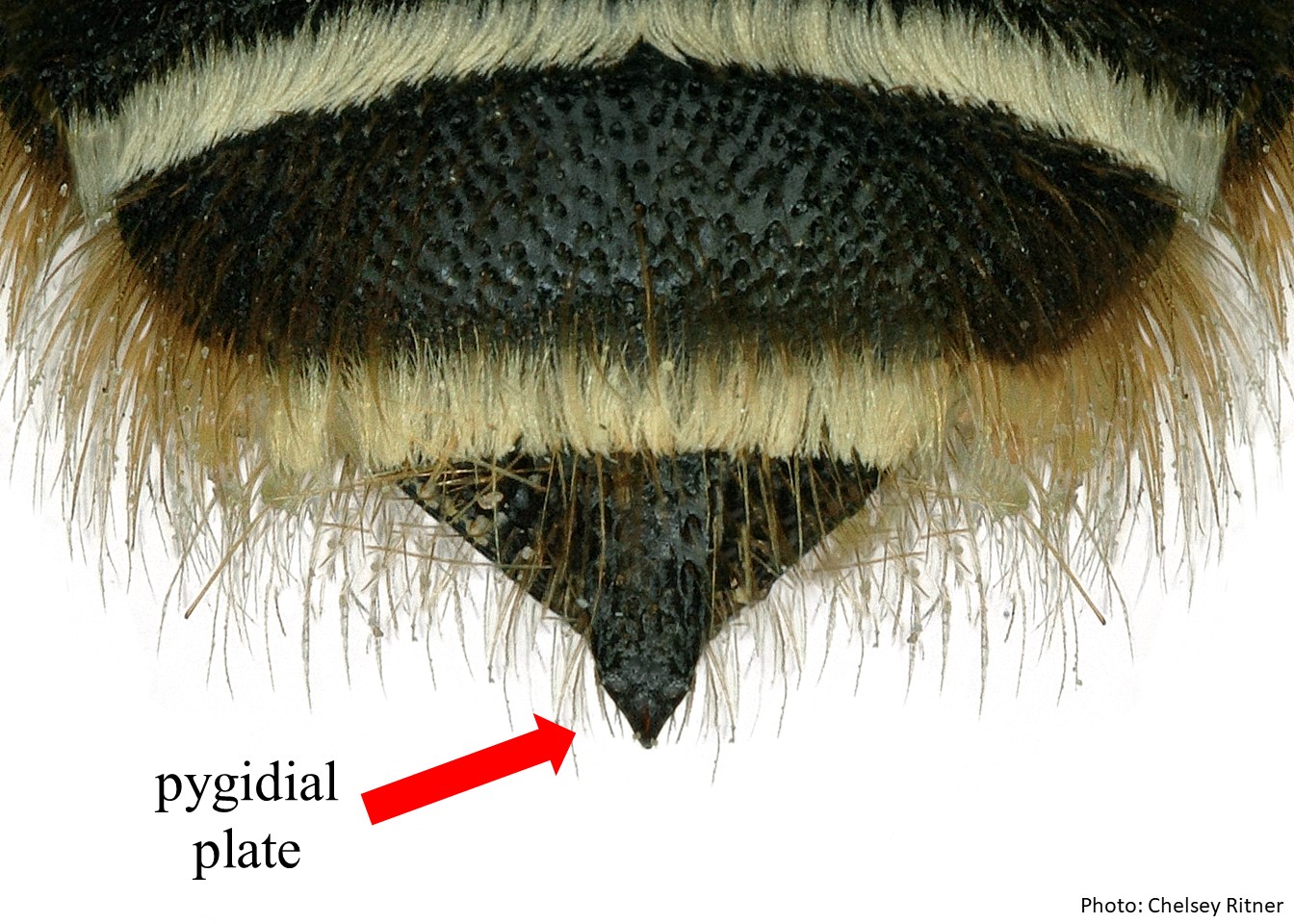Family: Megachilidae
Subfamily: Fideliinae
Tribe: Pararhophitini
Genus: Pararhophites Friese, 1898
Subgenera: none
Common name: none
Pararhophites range in body length from 5–7 mm (Michener 2007Michener 2007:
Michener, C.D. 2007. The Bees of the World (2nd ed.). Johns Hopkins University Press, Baltimore and London, 953 pp.). They are sexually dimorphicdimorphic:
having two distinct forms
, with females being primarily yellow, while males are black or brown with yellow patterning on the legs and abdomen (Michener 2007Michener 2007:
Michener, C.D. 2007. The Bees of the World (2nd ed.). Johns Hopkins University Press, Baltimore and London, 953 pp.). Pararhophites are the only nonparasitic Megachilidae genus without sternal scopascopa:
modified hairs for carrying pollen; often branched and dense hairs on the hind-leg, or on the ventral surface of the abdomen in Megachilidae
(Michener 2007Michener 2007:
Michener, C.D. 2007. The Bees of the World (2nd ed.). Johns Hopkins University Press, Baltimore and London, 953 pp.).
(modified from Michener 2007Michener 2007:
Michener, C.D. 2007. The Bees of the World (2nd ed.). Johns Hopkins University Press, Baltimore and London, 953 pp.)
 twice as long as prestigmaprestigma:
twice as long as prestigmaprestigma: without distinct pygidial platepygidial plate:
without distinct pygidial platepygidial plate: .
. tridentate or trilobed.
tridentate or trilobed.Pararhophites is unique within Megachilidae, especially the females, due to the scopascopa:
modified hairs for carrying pollen; often branched and dense hairs on the hind-leg, or on the ventral surface of the abdomen in Megachilidae
on their hind tibiatibia:
the segment of the leg, between the femur and the tarsus, so it is unlikely to be confused with any other genera within the family.
There are no known invasives.
Pararhophites are believed to be generalists on Zygophyllaceae. Pararhophites quadratus has been found to utilize Zygophyllum (Michener 2007Michener 2007:
Michener, C.D. 2007. The Bees of the World (2nd ed.). Johns Hopkins University Press, Baltimore and London, 953 pp.). Peganum harmala may also be an important host plant for Pararhophites (McGinley and Rozen 1987McGinley and Rozen 1987:
McGinley, R.J. and J.G. Rozen Jr. 1987. Nesting biology, immature stages, and phylogenetic placement of the Palaearctic bee Pararhophites (Hymenoptera: Apoidea). American Museum Novitates 2903: 1ndash;21.).
Only the solitary nesting habits of P. orobinus are known. They have been observed nesting in small aggregations, where they excavate irregularly shaped nests belowground with an entrance burrow leading to multiple branches (McGinley and Rozen 1987McGinley and Rozen 1987:
McGinley, R.J. and J.G. Rozen Jr. 1987. Nesting biology, immature stages, and phylogenetic placement of the Palaearctic bee Pararhophites (Hymenoptera: Apoidea). American Museum Novitates 2903: 1ndash;21.). Cells are formed from pollen and sand grains moistened with nectar (McGinley and Rozen 1987McGinley and Rozen 1987:
McGinley, R.J. and J.G. Rozen Jr. 1987. Nesting biology, immature stages, and phylogenetic placement of the Palaearctic bee Pararhophites (Hymenoptera: Apoidea). American Museum Novitates 2903: 1ndash;21.). A mix of wet and dry pollen is provisioned into a receptacle in the rear of the cell (McGinley and Rozen 1987McGinley and Rozen 1987:
McGinley, R.J. and J.G. Rozen Jr. 1987. Nesting biology, immature stages, and phylogenetic placement of the Palaearctic bee Pararhophites (Hymenoptera: Apoidea). American Museum Novitates 2903: 1ndash;21.). The species goes through diapausediapause:
a period of dormancy during development, generally during unfavorable environmental conditions
within their cocoons (McGinley and Rozen 1987McGinley and Rozen 1987:
McGinley, R.J. and J.G. Rozen Jr. 1987. Nesting biology, immature stages, and phylogenetic placement of the Palaearctic bee Pararhophites (Hymenoptera: Apoidea). American Museum Novitates 2903: 1ndash;21.). Post defecating, inactive larvaelarvae:
active immature form of an insect, especially one that differs greatly from the adult and forms the stage between egg and pupa
can remain in diapausediapause:
a period of dormancy during development, generally during unfavorable environmental conditions
for more than 5 years (Rozen 1990Rozen 1990:
Rozen Jr., J.G. 1990. Pupa of the bee Pararhophites orobinus (Hymenoptera: Apoidea: Megachilidae). Journal of the New York Entomological Society 98: 379ndash;382.).
Pararhophites can be found in Morocco west to Egypt and from Kazakhstan south to Pakistan and northwestern India (Michener 2007Michener 2007:
Michener, C.D. 2007. The Bees of the World (2nd ed.). Johns Hopkins University Press, Baltimore and London, 953 pp.).
Distribution map generated by Discover Life -- click on map for details, credits, and terms of use.
McGinley, R.J. and J.G. Rozen Jr. 1987. Nesting biology, immature stages, and phylogenetic placement of the Palaearctic bee Pararhophites (Hymenoptera: Apoidea). American Museum Novitates 2903:1-21.
Michener, C.D. 2007. The Bees of the World (2nd ed.). Johns Hopkins University Press, Baltimore and London, 953 pp.
Rozen Jr., J.G. 1990. Pupapupa:
an insect in its inactive immature form between larva and adult
of the bee Pararhophites orobinus (Hymenoptera: Apoidea: Megachilidae). Journal of the New York Entomological Society 98:379-382.